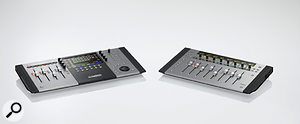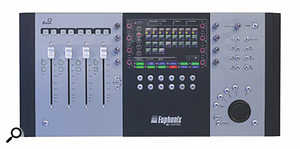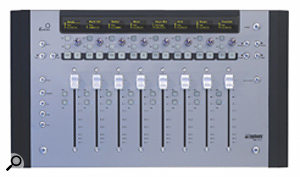Published 17/1/08
Artist Series brings professional control to your fingertips

High-end console giants Euphonix have made some significant product announcements at the NAMM show, which is happening now in Anaheim, California. The company have introduced what they’re calling their Artist Series, for which you may have seen ‘teaser’ adverts in recent editions of SOS magazine. There are two new products: the MC Mix and the MC Control, both of which are control surfaces for operating Digital Audio Workstations (DAWs).

The MC Control, pictured right, uses a generous touch screen to communicate with the attached DAW. From this, you can call up and edit channel settings, meter signals, and essentially control most of the common features of your sequencing software. Soft keys are the order of the day: there are 12 of them beneath the MC Control’s screen, and they are banked and fully assignable so that you can allocate your favourite feature to a specific button. There are eight assignable rotary encoders flanking the screen. These can be used to change EQ parameters or channel gain settings, for example. To the left of the screen, there are four motorised faders, complete with Solo, On, Select and Record enable buttons. Of course, these are also banked, so you can manually scroll through and ride the fader of any channel in your DAW, but you can also set up and assign mix stems to the four faders. The right-hand side of the MC Control accommodates a variety of useful left/right controls, including Nudge, Page and Bank, while a full transport control fans out from the jog/shuttle wheel.
 The MC Mix, as you can see from the pictures doesn’t feature the touch screen or transport section of the MC Control, but has an extra four motorised faders, making eight in total. Each channel has its own assignable rotary encoder, as well as the aforementioned channel selection buttons and a small but detailed OLED (Organic Light-Emitting Diode) display. There are hot-keys for accessing the connected DAW channel’s inserts and auxiliary sends, and the same left/right Nudge, Page and Bank controls that are found on the MC Control appear on the MC Mix’s top panel.
The MC Mix, as you can see from the pictures doesn’t feature the touch screen or transport section of the MC Control, but has an extra four motorised faders, making eight in total. Each channel has its own assignable rotary encoder, as well as the aforementioned channel selection buttons and a small but detailed OLED (Organic Light-Emitting Diode) display. There are hot-keys for accessing the connected DAW channel’s inserts and auxiliary sends, and the same left/right Nudge, Page and Bank controls that are found on the MC Control appear on the MC Mix’s top panel.
Each unit has a single Ethernet port, which can be connected directly to the host computer, or hooked up to conventional LAN switching equipment, enabling a number of devices to be set up in a system. Should you wish to utilise multiple MC Controls and Mixes, they can be slotted together to form a long mixing console-like arrangement.
The new range works on the same EuCon (Euphonix Control Network) protocol as the larger Euphonix consoles found in facilities such as Pinewood, Shepperton and Skywalker Sound, which enables control of almost any parameter or chain of processes. This makes them potentially more flexible than any other control surfaces ever targeted at home and project studio users. EuCon was first introduced in 1999, and was originally created to control the DSP cores on the company’s large consoles. By working with external developers, chiefly Steinberg, Merging Technologies and Apple, Euphonix have been able to integrate EuCon directly into music software packages from these companies.
Unlike the large Euphonix consoles, where a dedicated processor runs the EuCon software, the Artist series comes with a version of EuCon that runs on the same computer as the DAW. Depending on the sequencing software in use, the communication method between the control surface and the DAW varies. Some applications are what Euphonix refer to as ‘EuCon aware’, and these include Apple’s Logic Pro 8, Steinberg’s Nuendo and Pyramix from Merging Technologies. When such an application is being used, EuCon interfaces directly with the host, and integrates at a deep level. For those applications that are not ‘aware’, EuCon emulates Mackie Control or HUI protocols, enabling control of applications such as Pro Tools and Digital Performer.
EuCon has a number of advantages over HUI, which is perhaps the most widely used protocol for small DAW controllers at present. HUI uses MIDI to send and receive information, even for controllers which connect via USB, so its capacity is limited by the MIDI bandwidth of 31.25kbaud. By contrast, EuCon runs over 100 Base-T Ethernet and so can operate at up to 100 megabits per second. Thus there is an enormous amount of headroom in EuCon, whereas HUI tends to slow down as more devices are connected and used.
Further to this is the issue of resolution. For example, HUI faders transmit 512 discrete values, whereas EuCon accommodates 1024. The knobs are more accurate too, with 128 values at fixed resolution for HUI, yet infinite resolution for EuCon, allowing for better detection of the acceleration and velocity of the knob adjustments.
Watch out for a forthcoming SOS review, where we’ll be able to put the Artist series through its paces. The new controllers will be available in late January, and are expected to cost around £980 for the MC Control and £699 for the MC Mix, both including VAT.
Hilgrove Kenrick & Chris Mayes-Wright.
Euphonix Europe +44 (0)208 561 2566
www.euphonix.com

High-end console giants Euphonix have made some significant product announcements at the NAMM show, which is happening now in Anaheim, California. The company have introduced what they’re calling their Artist Series, for which you may have seen ‘teaser’ adverts in recent editions of SOS magazine. There are two new products: the MC Mix and the MC Control, both of which are control surfaces for operating Digital Audio Workstations (DAWs).

The MC Control, pictured right, uses a generous touch screen to communicate with the attached DAW. From this, you can call up and edit channel settings, meter signals, and essentially control most of the common features of your sequencing software. Soft keys are the order of the day: there are 12 of them beneath the MC Control’s screen, and they are banked and fully assignable so that you can allocate your favourite feature to a specific button. There are eight assignable rotary encoders flanking the screen. These can be used to change EQ parameters or channel gain settings, for example. To the left of the screen, there are four motorised faders, complete with Solo, On, Select and Record enable buttons. Of course, these are also banked, so you can manually scroll through and ride the fader of any channel in your DAW, but you can also set up and assign mix stems to the four faders. The right-hand side of the MC Control accommodates a variety of useful left/right controls, including Nudge, Page and Bank, while a full transport control fans out from the jog/shuttle wheel.
 The MC Mix, as you can see from the pictures doesn’t feature the touch screen or transport section of the MC Control, but has an extra four motorised faders, making eight in total. Each channel has its own assignable rotary encoder, as well as the aforementioned channel selection buttons and a small but detailed OLED (Organic Light-Emitting Diode) display. There are hot-keys for accessing the connected DAW channel’s inserts and auxiliary sends, and the same left/right Nudge, Page and Bank controls that are found on the MC Control appear on the MC Mix’s top panel.
The MC Mix, as you can see from the pictures doesn’t feature the touch screen or transport section of the MC Control, but has an extra four motorised faders, making eight in total. Each channel has its own assignable rotary encoder, as well as the aforementioned channel selection buttons and a small but detailed OLED (Organic Light-Emitting Diode) display. There are hot-keys for accessing the connected DAW channel’s inserts and auxiliary sends, and the same left/right Nudge, Page and Bank controls that are found on the MC Control appear on the MC Mix’s top panel.Each unit has a single Ethernet port, which can be connected directly to the host computer, or hooked up to conventional LAN switching equipment, enabling a number of devices to be set up in a system. Should you wish to utilise multiple MC Controls and Mixes, they can be slotted together to form a long mixing console-like arrangement.
The new range works on the same EuCon (Euphonix Control Network) protocol as the larger Euphonix consoles found in facilities such as Pinewood, Shepperton and Skywalker Sound, which enables control of almost any parameter or chain of processes. This makes them potentially more flexible than any other control surfaces ever targeted at home and project studio users. EuCon was first introduced in 1999, and was originally created to control the DSP cores on the company’s large consoles. By working with external developers, chiefly Steinberg, Merging Technologies and Apple, Euphonix have been able to integrate EuCon directly into music software packages from these companies.
Unlike the large Euphonix consoles, where a dedicated processor runs the EuCon software, the Artist series comes with a version of EuCon that runs on the same computer as the DAW. Depending on the sequencing software in use, the communication method between the control surface and the DAW varies. Some applications are what Euphonix refer to as ‘EuCon aware’, and these include Apple’s Logic Pro 8, Steinberg’s Nuendo and Pyramix from Merging Technologies. When such an application is being used, EuCon interfaces directly with the host, and integrates at a deep level. For those applications that are not ‘aware’, EuCon emulates Mackie Control or HUI protocols, enabling control of applications such as Pro Tools and Digital Performer.
EuCon has a number of advantages over HUI, which is perhaps the most widely used protocol for small DAW controllers at present. HUI uses MIDI to send and receive information, even for controllers which connect via USB, so its capacity is limited by the MIDI bandwidth of 31.25kbaud. By contrast, EuCon runs over 100 Base-T Ethernet and so can operate at up to 100 megabits per second. Thus there is an enormous amount of headroom in EuCon, whereas HUI tends to slow down as more devices are connected and used.
Further to this is the issue of resolution. For example, HUI faders transmit 512 discrete values, whereas EuCon accommodates 1024. The knobs are more accurate too, with 128 values at fixed resolution for HUI, yet infinite resolution for EuCon, allowing for better detection of the acceleration and velocity of the knob adjustments.
Watch out for a forthcoming SOS review, where we’ll be able to put the Artist series through its paces. The new controllers will be available in late January, and are expected to cost around £980 for the MC Control and £699 for the MC Mix, both including VAT.
Hilgrove Kenrick & Chris Mayes-Wright.
Euphonix Europe +44 (0)208 561 2566
www.euphonix.com
